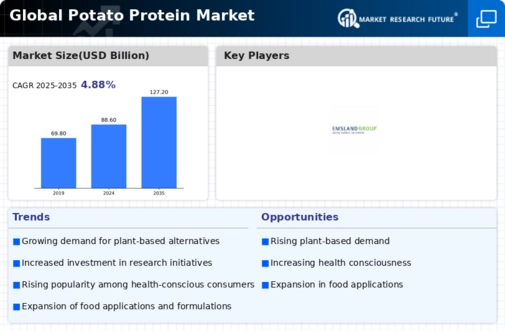Market Share
Potato protein market Share Analysis
The Potato Protein Market, a pivotal segment within the food and beverage industry, employs strategic market positioning to establish a strong presence and capture a significant share of the market. Companies in this sector utilize a variety of strategies, including product differentiation, cost management, and innovation, to navigate consumer preferences and maintain a competitive edge.
A fundamental strategy in the Potato Protein Market involves product differentiation. Companies aim to distinguish their potato protein offerings by emphasizing unique characteristics such as purity, solubility, or applications. For example, a company might highlight its commitment to producing non-GMO, allergen-free potato protein with high nutritional value, appealing to consumers seeking clean-label and plant-based protein alternatives. This differentiation not only attracts customers with specific dietary preferences but also contributes to building a recognizable brand identity in a market characterized by protein diversity.
Cost leadership is another essential market share positioning strategy in the Potato Protein Market. Companies strive to become the cost-effective provider of high-quality potato protein by optimizing production processes, sourcing raw materials efficiently, and achieving economies of scale. This cost-conscious approach resonates with a broad consumer base, especially in markets where price sensitivity influences purchasing decisions. By becoming a cost leader, companies can offer competitive prices without compromising on the quality of their potato protein, thereby securing a larger market share.
Innovation plays a crucial role in the Potato Protein Market, with companies investing in research and development to create novel formulations and applications. Staying ahead of technological advancements enables companies to introduce potato protein products with improved functionalities, such as enhanced solubility, stability, or nutritional profiles. This innovation-centric approach not only addresses evolving consumer preferences but also positions companies as leaders in providing cutting-edge solutions for the food and beverage industry.
Strategic partnerships and collaborations are integral to market share positioning within the Potato Protein industry. Companies often form alliances with food manufacturers, research institutions, or other players in the protein supply chain to enhance product development, explore new applications, and expand market reach. Collaborative efforts can lead to improved production processes, sustainable sourcing practices, or the creation of specialty potato protein products, ultimately strengthening a company's market position.
Geographical expansion is a significant strategy in the Potato Protein Market, allowing companies to tap into new markets with diverse industry needs. This expansion may involve adapting products to meet regional preferences, complying with local regulations, and establishing distribution networks. By understanding and catering to the unique tastes and preferences of consumers in different regions, companies can broaden their market share and solidify their position as global leaders in the potato protein sector.
Customer-centric strategies are paramount in the Potato Protein Market, where consumers prioritize clean-label, sustainable, and plant-based protein alternatives. Companies focus on building trust through transparent labeling, providing detailed information about the sourcing and processing of potato protein, and ensuring compliance with sustainability standards. Engaging with consumers through educational initiatives, online platforms, and participation in industry events helps companies establish a strong connection with their audience, fostering brand loyalty and solidifying market share.




Leave a Comment